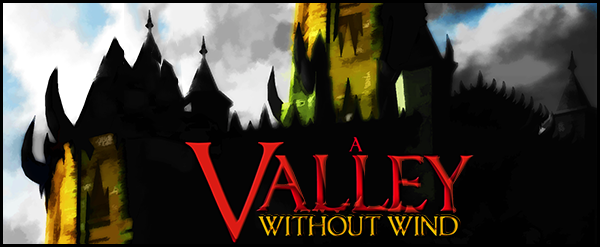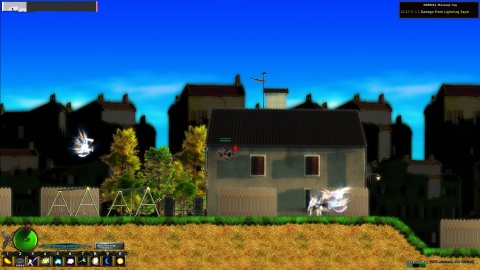A Valley Without Wind
 There are ambitious indie games like Fez, which go all out on their
insane puzzles and clever solutions. Then there are ambitious indie
games like the Blackwell series, which tells a tale of death with
believable characters and full voice acting. And then there are
ambitious indie games like A Valley Without Wind, which features a fully
procedurally generated, side-scrolling action, massively multiplayer
online world.
There are ambitious indie games like Fez, which go all out on their
insane puzzles and clever solutions. Then there are ambitious indie
games like the Blackwell series, which tells a tale of death with
believable characters and full voice acting. And then there are
ambitious indie games like A Valley Without Wind, which features a fully
procedurally generated, side-scrolling action, massively multiplayer
online world.
Developed by Arcen Games, A Valley Without Wind is, if anything, ambitious. It’s also genre defining, I personally haven’t played a lot of action RPG 2D MMOs, but now at least one exists. Released last week for Windows and Mac, here are our impressions on the game. They’re unsurprisingly varied.
Nate
My first experience of A Valley Without Wind, with which I was totally unfamiliar, was negative. The game's title primed me for a high-fantasy adventure obsessed with its own lore, and the text-crawl in the game's opening menu ("It is the year 888") didn't help matters. I was not and am not terribly interested in figuring out the narrative of this game. Some kind of doomsday happened, and now the world is all disorganized, and I control characters who shoot magic, and I have to help build a settlement for those without magic, and also there is this evil guy to kill eventually. Whatever. I don't care what year it is in ValleyWind. "Let's go kill monsters," I said to myself, "maybe that will be cool."
So I joined Greg on the only server available and woke up in a town full of NPCs running around. Considering the title, I was surprised that there were no dragons or knights, only sci-fi looking people that were sometimes comically tall. As they passed me by, dialog windows and menus assaulted my computer screen unprompted, triggering traumatic flashbacks to Windows ME and its errors that swarmed like locusts. I had to escape the noise. I went left. I don't know where Greg went. I left him to the buzzing hive of menus and NPC small talk. Every man for himself. I fled left.
It was snowy to the left, but nobody was there to bother me. It was safe to experiment. I clicked the left mouse button, and a small wood platform appeared. I jumped on it. I made another, above me, and jumped on that. There was nothing further up to jump to, so I jumped off and continued moving left. To the left was more snow, and tons of those small wood platforms scattered everywhere, as if I had already been there in a past life. But other than the winding snow paths and plethora of randomly placed platforms, there was nothing. No items, enemies, anything. I continued left until the path left ended. I wasted about twenty minutes.
I decided I should probably do something in this game other than walking aimlessly in the snow, so I met Greg back in the town and resigned myself to reading menus for a bit. In a few minutes, I loaded up my character with some magic spells and followed Greg to a "mission" spot on the world map. Once again, left was the path, only this time there were knights and skeletons and such to fight. We jumped over their slow-moving spells and fired back with our own, which the enemies didn't care to avoid. After about fifteen minutes of this, we hit a wall. Can't go any farther left. Doesn't seem to be anywhere else to go. What was the point of this? We logged out.
Days later, I decided I should give the game a shot in singleplayer. Maybe there were some light introductions to the game elements that would explain the ambiguous HUD. A trail of gravestones laid out the controls and basics of map navigation, which is important in a game with a randomly generated world layout and some brief dungeon-like areas scattered about. There are also some dilapidated buildings that seem to be empty. I explored them anyway. Nothing inside.
The caves were another story, full of armor knights that give slow chase while being shot with lightning bolts and red skeletons that shoot fireballs. The action-platforming encounters were definitely the highlight of my experience, even if the affair lacked impact: without the big numbers that display the damage with each hit, you'd think the characters were tickling each other with those fireballs, as they don't react to damage until they disintegrate upon death. Still, there was a surprising bit of strategy in avoiding enemy attacks while staying in position to whittle them down. It's a lower level of Bullet Hell than that of a shmup, appropriate for the restrictive gravity of platforming. It didn't blow me away, but it showed promise.
Unfortunately, that's the only part of A Valley Without Wind that really grabbed me. The game seems designed for those who enjoy mapping frontiers for resources, which are used to build up the home settlement, which enables longer excursions into more dangerous territory, and so on. I'm afraid my attention span just isn't conducive to that kind of exploration-first experience anymore, unless the action in between is particularly thrilling. And to its credit, there's potential in the combat, though it's not immediately compelling. I'm interested in seeing what kind of enemy variety the game comes up with, but not enough so that I plan on playing through the exploration and base camp construction.
Steve
I must admit, I was worried about this game while watching preview videos and hearing the words "procedurally generated." At first glance, the game's simple animations, basic sound design and cut-out visuals (think And Yet It Moves sans paper theme) portrayed an image of a cheap, barebones experience. However, once I started playing, my fears soon vanished and I only became more and more intrigued.
On startup, the game takes you directly to its title screen, which gives you a menu, a background, and a scrolling story. Same as everything, right? But the nuances and complexities of this screen sum up AVWW in a microcosm. The menus are deep, yet understandable. Any options that aren't undeniably clear are explained fully, yet simply. Complex items are explained in the best ways possible for people to understand. The scrolling story gives you enough background to give a purpose of playing the game and heading through the world, as well as deepening all interactions you encounter. Important words and phrases are color-coded for understanding. The game's credits immediately follow the story for efficiency of space. The bottom-right hand corner of the screen offers a cheat-sheet on controls. You may not fully realize it all while starting, yet you'll soon remember and be able to look back. This is topped off by a version number (since you can take part in beta tests) and an attractive random world background. This title screen alone, without even touching the game yet, immediately pushes on you that the developers know what they're doing.
The game starts the same way. Once the world is generated and you pick a "character," you begin playing on some mostly-empty screens. It guides you through obtaining and using abilities, interacting with the environment and learning basic movement. This is all done by saying very little to nothing. Once you obtain the ability and understand the utility behind building platforms, the game starts opening up a little in your mind. And more, when you find a long-range attack. And more, as you gain character movement abilities. And more, when you find a dungeon, which inside guides you towards valuables, mini-bosses, and new abilities. And more, as you continue to fight your first boss and visit your first settlement and continue to the world map and explore new zones. The entire game guides players extremely well, with efficiency and minimal intrusion. Any intrusion must have clear reason and purpose. The procedural generation, which can be particularly worrysome, appears to be integrated perfectly with initial player learning. Procedural generation's other big problem is also often overly easy/difficult scenarios, but I haven't encountered any of those yet (although due to time constraints, I've really only scratched the surface).
Technically speaking, A Valley Without Wind is very impressive, which I also did not expect. It looks and plays extremely well, especially from a small team. Controls are near-perfect for a keyboard/mouse setup. From what I've seen, the game is also going to receive consistent content updates for a long, long time. After playing, you want to concede that the cut-out images are a good choice for this title, considering its randomly generated nature. I still think animations could be improved, despite being a bit limited by character customization options, but that also becomes irrelevant once you start actually playing the game. Collisions and hits could use a bit of tweaking as well, but overall I am very impressed by this game's backend and features.
I come away with a bit of difficulty just to explain this game as a whole. It is certainly a rogue-like, first and foremost, but with a heavy emphasis on action. The action is smooth, fast, and precise. It has fully integrated multiplayer and near-infinite content to explore (with plans to add more). It's not the easiest to explain or get people hyped about, but that's what the trial is for. I highly recommend trying it.
Greg
I'm with Nate on this one, jumping into what was apparently an already complete server as our first time was an unavoidable disaster. This is a deep and dense game and we didn't even understand the basics. I'm not a big fan of tutorials, but knowing that starting a single player game actually teaches you everything you need would have been a big help. Instead, I left my first session with a sour taste in my mouth.
Also like Nate, I gave it a few days to wash out, and my return was much more palpable. The single player experience, while still wordy at times and a bit confusing, is a much better way to start. It's kind of curious the bad habits the full multiplayer server instilled on me. For one, I wasn't expecting so many bad guys! And secondly, yeah, you really need to take the time to read all the signs, hints, and gravestones. They actually do help.
I'm still not sold on the art style, it seems like it's out of balance with the rest of the game. As in, the gameplay is really quite good and the controls are excellent, but the sprites are just kind of... eh. I think we're spoiled on games like Bastion and Braid, however, which just look balls-out stellar.
Not a game for everyone, not even for a very big percentage of gamers, but those gamers out there who are looking for A Valley Without Wind and didn't even realize it are in for a treat.

